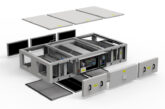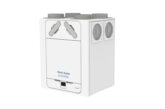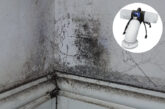
Jenny Smith, Head of Marketing at Vent-Axia, looks at the benefits of using ventilation to fight COVID and why electricians are well placed to help.
Ventilation is now well proven in the fight against COVID-19 with Public Health England’s guidance ‘COVID-19: epidemiology, virology and clinical features’ acknowledging that airborne transmission can occur in ‘poorly ventilated’ spaces. Add to this the Government’s public information campaign which highlights how ventilating indoor spaces can reduce the risk of coronavirus infection by over 70%1 and it’s clear that improving ventilation is key.
So, how can electricians help? Improving ventilation in any form helps reduce transmission but, using extractor fans removes the virus more quickly than just opening a window, which is explained in a recent public information film which is part of the Government’s ‘Hands. Face. Space’ campaign. So, in homes, work places and retail and leisure spaces it’s essential existing ventilation is evaluated and then improved if needed to achieve sufficient ventilation to help reduce the potential concentration of virus in the air.
Improving ventilation
Ventilation plays an important role in reducing indoor pollution since it is able to bring in fresh air and exhaust stale, potentially virus-laden, air. Without effective ventilation, people are potentially exposed to a higher concentration of airborne pathogens, and the risk increases over time. This can be demonstrated as: Risk = exposure x time.
Increasing the airflow increases the effectiveness at reducing transmission so ventilation systems should be set up to maximise the amount of fresh air in a room. It’s also essential that air is not re-circulated within a building – systems should supply as much outside air as possible. This may include opening windows in additional to mechanical ventilation – even if it is at the expense of thermal comfort.
Domestic solutions
There are a range of domestic ventilation solutions available, depending on whether it is for retrofit or new build. In bathrooms, kitchens and other ‘wet’ rooms it is easy to upgrade any existing ventilation with the latest intermittent extractor fans which are triggered either by a humidistat or light switch. Alternatively, Single Room Heat Recovery (SRHR) uses the heat from the extracted stale air to warm up the incoming fresh air, providing ventilation whilst also saving energy. This is easier to retrofit than a wholehouse ventilation system and is ideal for when energy efficient heat recovery is required on a room-by-room basis.
Meanwhile for new builds, MVHR (mechanical ventilation with heat recovery) is a whole house ventilation system that continuously supplies filtered air and extracts continuously at a low rate with a boost facility when required. Furthermore, Positive Input Ventilation (PIV) pushes out any stale air and replaces it with filtered air from outside, increasing the circulation of fresh air around the property and improving indoor air quality (IAQ).
 Commercial solutions
Commercial solutions
In the commercial sector it is essential that pubs, gyms and other businesses are COVID-aware and make their buildings as safe as possible. This includes increasing the air supply and exhaust ventilation, supplying as much outside air as is reasonably possible to dilute and remove the virus as much as possible. If an existing ventilation system isn’t able to provide enough airflow this is where electricians can make a big difference advising on and installing an appropriate system.
Gyms have proven particularly challenging when it comes to making them COVID-Secure due to the higher risk of virus transmission. The Government guidance3 has therefore provided clear advice on how to optimise ventilation. By reducing occupancy and maintaining airflow the typical current airflow of 10 l/s/p will be increased to at least 20l/s/p.
Pubs also have a challenge on their hands when open with people ideally wishing to remain inside for prolonged periods of time in cold or wet weather, increasing risks of transmission. When smoking was allowed in pubs, ventilation guidance was to replace the air in a room every 8 minutes to extract the smoke and create a healthier indoor environment, protecting staff and customers. Today the same solution can be used in the fight against this new invisible enemy while helping pubs maintain a COVID-secure establishment. Installed and correctly commissioned in pubs, fans will extract the polluted air, including any viruses, replacing it with fresh air every 8 minutes, thereby diluting the impact of the virus and reducing transmission.
It’s understandable some gyms and pubs may think upgrading ventilation is a big job, but this just isn’t the case at all with the right product. Ease of installation and replacement is an important factor when choosing ventilation products, especially at the moment, since this saves time on site and so reduces costs. Today it is simple to replace traditional extract/supply fans with modern alternatives which will reliably supply effective ventilation and offer an energy efficient solution to help reduce running costs. These modern extract/supply fans can also be added when a property needs some extra airflow.
For example, Vent-Axia’s Lo-Carbon T-Series Fan range offers high performance ventilation with low running costs. Alternatively, to upgrade a current ventilation system, electricians can suggest demand ventilation as a solution to business owners. D-ERV systems have sophisticated controls and sensors that can be used to easily adapt the system to the new COVID-19 requirements, providing ventilation appropriate to occupant needs.
For instance, Vent-Axia’s Sentinel Totus² Demand Energy Recovery Ventilation system (D-ERV) has a range of sensors, such as CO2, PIR occupancy detection, humidity or temperature to determine the room’s air quality, adjusting the ventilation requirements automatically and managing the system’s ventilation rates accordingly. The levels for these sensors can also be adjusted to ensure they provide the higher levels of ventilation now required e.g. lowering the CO2 setpoint to 400ppm.
With ventilation repeatedly suggested by Government as a way to reduce COVID-19 indoors, coupled with academic papers confirming aerosol transmission of the virus, the Government is now clearly supporting effective ventilation in the fight against COVID-19. Electricians are well placed to work across domestic and commercial settings to install the latest ventilation solutions to provide enough airflow to dilute the virus in the air and improve indoor air quality.
Vent-Axia has consolidated all the useful information and guidance in a useful guide called ‘The Effect of Ventilation on COVID-19’ and a companion webpage, which gives practical advice on how indoor ventilation is important to reduce virus transmission.
Visit Vent-Axia’s indoor ventilation practical advice site by clicking here








